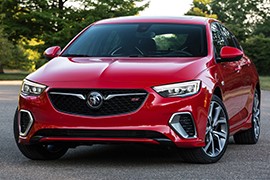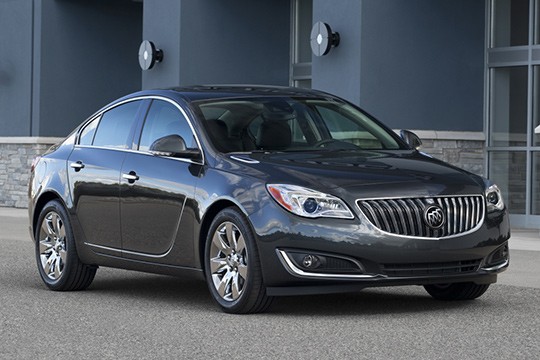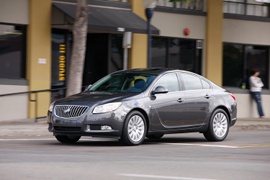BUICK Regal Models/Series Timeline, Specifications & Photos
First production year: 1988
Engines: Gasoline, , Mild hybrid
The sixth generation of the Regal was introduced in 2017 as a 2018 model-year, and it was based on the same platform as the European Opel/Vauxhall Insignia.
The Regal GS was a new addition to the American brand. Its fresh design was on par with other premium automakers from the same era and targeted families that didn't want to drive the commonly used Camry, Avalon, or Accord. Moreover, Buick offered the Regal with an all-wheel drive system, which was not available for its main competitors. Only the European premium automaker had something like this in their offer.
When it developed the Regal, General Motors invested more than pennies into the car's look. The car's angular headlights flanked a broad black grille where the Buick badge took center stage. In addition, the front bumper sported large side scoops that flanked a slim lower air intake. From its profile, the Regal revealed its European connection due to its sculptured door panels. At the back, the sloped rear windscreen was integrated into the tailgate. Finally, the rear fascia featured angular, slim taillights.
Inside, the automaker offered a pair of high-bolstered seats fitted as standard, with an option for sports seats. Like most other premium vehicles from the same segment, the GS sported an LCD placed in front of the driver and a second touch-screen panel atop the center stack. But Buick didn't forget about the trunk either. Thus, that could have been expanded from 490 liters (17.3 cu-ft) to 1,450 liters (51.2 cu-ft) by folding the rear bench seatback.
Under the hood, Buick offered the Regal with a choice of two gasoline units; a 2.0-liter turbocharged-four or a 3.6-liter V6 paired with a nine-speed gearbox that sent the power in all corners.
In 2008, Buick introduced a new generation of the Regal range to the North-American market. It was primarily based on the European Opel/Vauxhall Insignia. Four years later, it refreshed the lineup.
While the European branch struggled to survive and being just a step away to be bought by the Russian bank Sberbank, the U.S. model was well received on the market. The styling and the features offered by Buick for the Regal pushed the car into the premium segment.
GM unveiled the 2014 Buick Regal at the 2013 New York Auto Show. There were essential changes to the exterior. The car featured a new bumper design with wider air-intakes on the sides, where the fog lights were installed. The rear bumper was redesigned as well, and it featured two chromed exhausts under the apron. The LED technology found its way into the rear taillights and on the daytime running lights. The three-box sedan version featured an integrated lip-spoiler on the trunk-lid.
Inside, the Regal featured few modifications to the dashboard and for the infotainment system. The new instrument cluster featured a TFT color-display placed between the tachometer and speedometer. The design team relocated the lights knob upper than before, to be easier to reach by the driver.
The most significant improvement under the hood was the introduction of the 2.4-liter with light electrification assistance that transformed the car into a mild-hybrid vehicle. For those who were looking for more performance, Buick offered the Regal with a 2.0-liter turbocharged unit mated to a 6-speed manual as standard. It provided the car with an all-wheel-drive system. GM decided to offer a 6-speed automatic for both engine versions.
GM decided that it needed a facelifted version for the Buick's Regal lineup, and that came in 2012, four years after the model's introduction.
When the American giant developed the GM Epsilon II platform, it made it for four continents. Apart from Europe, where it sold the car under Opel and Vauxhall badges, it offered it in Australia as a Holden and in China as Buick Regal.
With a refreshed front fascia that resembled the European Opel/Vauxhall Insignia OPC/VXR, respectively, the Regal adopted its waterfall grille that supported the brand's logo in the middle. The tall and narrow air intakes on the sides were just carried over from its European siblings. Moreover, even the door panels featured the same sculptured areas, even though they could've made new ones. But they looked nice and, after all, why bother? At the back, apart from the logo, it was clearly a European (or Australian) vehicle, sporting the same taillights and, apart from Insignia, a horizontal chromed slat.
Inside, the Regal featured a similar dashboard to the European siblings, with four dials in the instrument cluster. On the left, a turning knob used for the headlights confirmed the German-inspired design. Moreover, the sloped center stack featured an infotainment display placed on top, with a dial that controlled it mounted between the gear-selector and the center armrest.
Under the hood, Buick installed a 2.0-liter inline-four mated to a six-speed automatic gearbox provided by Aisin. It sent its power to the front wheels and, starting with the 2014 model-year, with an option for all-wheel drive.
When GM designed a good car, it adapted it for various markets worldwide through its badge-engineering program. So it was the 2010 Buick Regal born as a European Vauxhall/Opel Insignia.
In 2008, Vauxhall was the first brand to introduce the Insignia at the London Motor Show, and soon, Opel unveiled the same vehicle in the same year, but with the steering on the left. In late 2009, GM uncovered the 2010 Buick Regal at the LA Auto Show.
At the time of its launch, Vauxhall/Opel offered the Insignia in two body versions: a hatchback and a classic, three-box sedan, but only the latter crossed the Atlantic and gained the Buick badge on the grille. Its sculptured side panels and doors visually increased the car's length, while the headlights were aggressive and featured daytime running lights. All the efforts of the designers toward the aerodynamics paid off with a spectacular Cd of 0.27.
Inside, there was a new design concept carried over from its European siblings with high-quality materials. But unfortunately, the car featured a shorter wheelbase than the Buick LaCrosse, which was its predecessor, which affected the knee-room in the back. On the plus side, the exterior length was smaller and thus easier to drive in traffic. A new infotainment generation included a seven-inch color monitor, a 3-D map view, a digital travel guide, and improved scroll and zoom functions.
Under the hood, GM took only the best engines from the European cousin. It offered the Regal with a choice of two, four-cylinder engines. The base version featured a 2.4-liter naturally aspirated unit, while the other two versions featured a 2.0-liter turbocharged four-pot.
The fourth generation of the Buick Regal was launched in 1997 and it was marketed as a sports sedan vehicle. It shared the platform with the Oldsmobile Intrigue, Pontiac Grand Prix, Chevrolet Lumina and Chevrolet Monte Carlo.
In the Buick stable, the Regal was the upmarket version of the Century and the main difference was the engine. The newly developed W-platform was used for more GM vehicles and it featured a front-engine front-wheel-drive system. The Regal was advertised as "The official car of the supercharged family", referring to the car's performances. The Regal was the first car to be launched online, on a dedicated website. The introduction was with a car breaking through a brick-like wall. The driver of that car was the Buick General Manager, Ed Mertz.
On the outside, the three-box sedan featured profiled headlights with rounded edges and turn-signals on the outer side, on the fenders. The GS trim level featured a two-tone paint as standard which was extended on both bumpers and a black grille. It was the top model, with a 3.8-liter supercharged engine.
Inside, the 1997 ½ Regal featured exclusive amenities such as heated seats, a premium sound system, a dual-zone climate control, and sunroof. There were two available instrument clusters for the driver and for the top-spec GS there was a tire pressure monitor.
Under the hood, the Regal was offered with a 3.8-liter V6 engine naturally aspirated for the base trim level and supercharged for the GS model. Some further modifications were made over the production time and increased the GS model power from a standard 240 hp up to 270 hp. Regardless of the trim level, the Regal was offered with a 4-speed automatic transmission only.
Buick tried to conquer a more significant chunk of the market with the third generation of the Regal. It was introduced in 1987 as a 1988 model year.
The new W platform was designed for better handling and comfort. It was the first front-wheel-drive Regal, and it showed a lack of experience in that area. Still, the comfort, look, and amenities led to enough sales, so the car was kept on the assembly lanes until 1996, with regular updates for the look and for the drivetrain.
The Regal's grille was inspired by the Greek Parthenon, guarded on its sides by the headlights. With big, corner-mounted, turn-signal lamps, it offered a premium look. But that image was kept only or a few years until GM started to change it. Initially, it was offered in a base Custom trim level, with an option for the Limited version. The red light strip in the back of the car provided a futuristic look for those times.
The interior was designed too conservative for customers that didn't want to experience new technologies. It was the same situation with the Cadillac buyers, who preferred walnut and leather instead. But Buick customers were surprised by the digital display, which was offered as an option. It wasn't any TFT or LCD unit, but a LED-based system. A bucket-seat option was available.
Under the hood, the Regal started with a 2.8-liter V6 engine that offered a mere 125 hp. Later on, a 3.1-liter and a 3.8-liter were added to the list. All of them were mated to a 4-speed automatic transmission.





